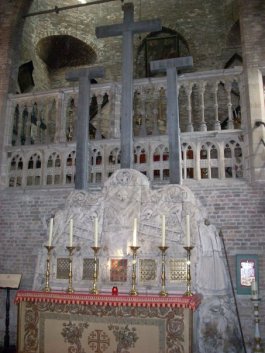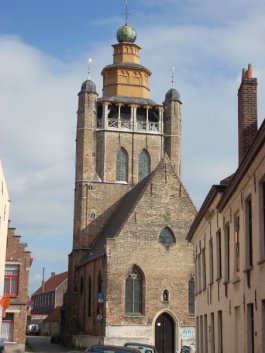The Flemish city of Bruges, or Brugge, has long been connected with Jerusalem. In his book City and Cosmos (2009), Keith Lilley described what he called “the perambulatory geography” of the medieval city, in which a vial of the Holy Blood was processed around Bruges. As Lilley describes it, the processional route of the Holy Blood encompassed both the centre and periphery of the city, symbolically connecting the cityscape in an image of cosmological harmony. This procession was certainly established by the year 1291; the little relic of Christ’s blood was used to protect the city against disaster whilst the city’s male citizens recited psalms and relived Christ’s Passion, as Bruges’ streets were made parallel to those of Jerusalem, a northern Via Dolorosa.
Much later, in the 1480s, a new monumental Jerusalem was built in Bruges. It is called the Jeruzalemkerk and it is very much on the tourist itinerary of this beautiful city. The church was built by the Adorno family, merchants with roots in Genoa but settled in Flanders. In 1483, the body of Anselmo Adorno was moved here from Scotland, where he had died.
The church is on the edge of the city, to the east. It comprises a chapel with a polygonal tower rising from it; below there is a vaulted crypt with a miniature tomb of Christ. The church’s main altar is a large replica of Calvary, in white ‘rock’, showing the Arma Christi, that is the instrument of Christ’s Passion.
By the early 16th century, a fraternity of Jerusalem pilgrims had been established at the church. The Adorno family had visited Jerusalem, and the family Church of Bruges replayed and remade some of the most memorable things they’d seen there. Quite how the Jeruzalemkerk was used is unclear, but once again we see a highly aesthetic, material and remediated landscape of Jerusalem rebuilt in the West.

Calvary rock, ?1420s, Jeruzalemkerk, Brugges, showing the Arma Christi (Instruments of the Passion).
Anselmo Adorno wrote a remarkable itinerary of his Eastern travels, published in French in 1978, edited by Jacques Heers. I wonder how far Adorno’s Jerusalem in Bruges improved on the eastern ‘original’? Is this church in Bruges a souvenir or a replica?
In Gerard David’s early sixteenth-century Baptism of Christ, now in the Groeningemuseum in Bruges, the church can be seen in the background, to represent the Jerusalem skyline, Christ’s baptism “brought home” to Bruges.


